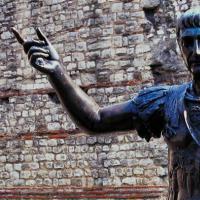Mesopotamia: the birth of civilization - Knowledge Hypermarket
>>History: Mesopotamia: the birth of civilization
Mesopotamia: the birth of civilization
1. Nature of Ancient Mesopotamia.
The very name Mesopotamia refers to the territory between the rivers. Indeed, in translation from the ancient Greek language, Mesopotamia means Mesopotamia. The mouths of the Tigris and Euphrates, before flowing into the Persian Gulf, form a vast delta of many separate river branches. Delta covers a triangular space, reminiscent of the ancient Greek letter delta. This is where the name comes from.
The area in the lower reaches of the Tigris and Euphrates is heavily swamped. The tides from the Persian Gulf brought bitter-salty water here. Many months of the year stand here heat . It took a long time for people to learn how to drain swampy places and irrigate the desert with the help of canals and dams. We can say that the labor of people made the lower reaches of the Tigris and Euphrates habitable and fertile.

2. Sumer is the oldest civilization.
The Sumerians settled in the lower reaches of the Tigris and Euphrates. One of the mysteries is connected with the Sumerians stories Ancient world. It is not known where they came to Mesopotamia. The Sumerian language is unlike any other. We know from surviving images that the Sumerians had oval faces with large eyes. It seems that they are aliens from other worlds. Both men and women wore skirts made of cloth, wool yarn or leaves. The men shaved their heads, and the women wore beautiful headdresses or capes.
The Sumerians built canals, with the help of which they drained areas that were flooded during the flood of rivers. They stored water in reservoirs and irrigated the fields with it during a drought. From unbaked clay, the Sumerians made bricks and built houses from them, and then large temples. Cities began to spring up around the temples.
The Sumerian cities were located on the hills and were surrounded by walls. The city and its districts had a certain territory. It was a city-state.
3. Sumerian city-states.
Sumerian cities were headed by rulers. First it was the high priests, and then the kings. The king was called "big man". Kings founded dynasties. Dynasty - a series of rulers from the same clan, successively replacing each other by right of inheritance.
Their tombs testify to the power and wealth of the Sumerian rulers. Archaeologists excavated the tombs of the kings of the city of Ur. Skeletons of dozens of people deprived of their lives were found here to accompany the lord to the afterlife, as well as precious treasures.

The largest and most powerful city-states of Sumer were Ur, Uruk, Lagash. The rulers of the city-states made laws. These were the first laws in history. They proclaimed that the king is the executor of the will of the supreme god of the city-state. The borders of the state were determined. The implementation of the laws and orders of the rulers was carried out through the officials appointed by them.

The city-state had its own treasury, which was at the disposal of the ruler. The city-states were at war with each other, so they needed an army. During the wars, the boundaries of city-states expanded. Several cities could be united under one king. Captured Sumerians were turned into slaves.

4. What is a state.
On the example of Sumer, you saw that the appearance civilizations associated with the emergence of the state. The state has a certain territory, borders, army, collects taxes from the population. Relations in society are regulated by laws. Various forms of state are known. In ancient times, a typical form of state was a monarchy. The supreme power in the monarchy belonged to one person: the king. shah, emperor. The inhabitants of the country, subordinate to the monarch, were called subjects. A country that has a single system of power, uniform laws, an army, a treasury (taxes), which has a certain territory and borders, is called a state.
IN AND. Ukolova, L.P. Marinovich, History, Grade 5
Submitted by readers from Internet sites
If you have corrections or suggestions for this lesson,


